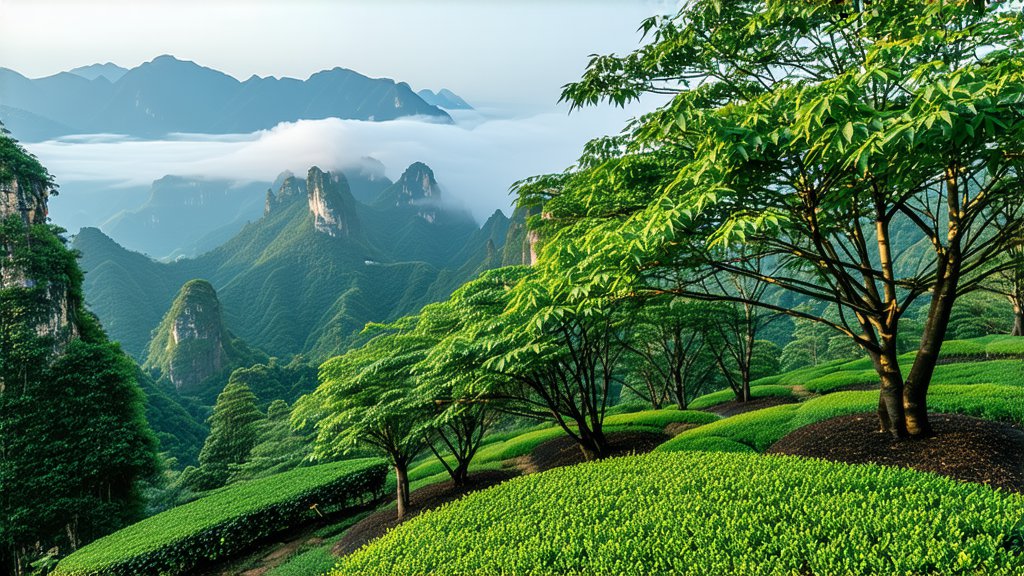
Introduction to Huangshan Maofeng
Nestled within the picturesque landscapes of Anhui province lies a hidden gem in the world of tea – Huangshan Maofeng. This exquisite yellow tea is not only a testament to China's rich tea heritage but also stands as a unique and rare offering among the diverse spectrum of tea varieties. Unlike its more popular counterparts, such as green or black tea, yellow tea like Huangshan Maofeng undergoes a meticulous process that results in its distinctive golden hue and subtle, nuanced flavors.
Historical Background
The origins of Huangshan Maofeng can be traced back to the Tang Dynasty (618-907 AD), making it a tea steeped in history. It was during this period that tea culture began to flourish in China, with various tea types being cultivated and consumed by the imperial court and common folk alike. The name "Huangshan Maofeng" translates to "Yellow Mountain Peak," referring to the stunning mountainous region where this tea is primarily grown. Over centuries, the cultivation and production methods have been refined, resulting in the unique characteristics that define Huangshan Maofeng today.
Types and Variations
While there are several types of yellow tea, Huangshan Maofeng is one of the most renowned. Its classification under yellow tea is due to the specific processing method that involves a gentle steaming or baking step after the initial stages of withering and fixing. This minimal processing allows the tea leaves to retain their natural moisture and enzyme activity, leading to the development of its characteristic yellow color and delicate flavor profile. Other notable yellow teas include Junshan Yinzhen and Moo Lue Yellow Tea, each with its own regional characteristics and flavor profiles.
Cultivation and Harvesting
The cultivation of Huangshan Maofeng tea plants is an art form in itself. Grown at high elevations on the slopes of the Yellow Mountains, these tea plants benefit from the cool climate, abundant rainfall, and fertile soil, all of which contribute to the exceptional quality of the tea. The best time for harvesting Huangshan Maofeng is during the early spring months when the tender new shoots and leaves are plucked with precision. Only the bud and the top few leaves are selected, ensuring that only the finest parts of the plant are used in the production of this premium tea.
Processing Techniques
The processing of Huangshan Maofeng is a meticulous and time-consuming process that requires skill and patience. After harvesting, the fresh leaves undergo a series of steps to transform them into the final product:
-
Withering: Freshly picked leaves are spread out in a well-ventilated area to allow them to lose some moisture. This step helps to soften the leaves and prepare them for subsequent stages.
-
Fixing (Pan-frying): The withered leaves are then lightly pan-fried at low temperatures. This step halts enzymatic oxidation while preserving the natural flavors and aromas of the tea.
-
Baking/Steaming: Following pan-frying, the leaves are subjected to gentle steaming or baking. This crucial step gives Huangshan Maofeng its signature yellow color and enhances its unique flavor profile. The leaves are carefully monitored to achieve the desired level of yellowing without overcooking.
-
Drying: Finally, the leaves are dried to reduce moisture content further, ensuring they remain shelf-stable without losing their delicate qualities.
Appreciating Huangshan Maofeng
To truly appreciate Huangshan Maofeng, one must engage in the traditional Chinese tea ceremony, which focuses on mindfulness, tranquility, and respect for the tea. Here’s how you can savor this exquisite tea:
-
Preparation: Begin by selecting a clean, transparent glass cup or a Yixing clay teapot to fully appreciate the visual beauty of the tea. Use water heated to around 80-85°C (176-185°F) to avoid scalding the delicate leaves.
-
Infusion: Place approximately 3-5 grams of Huangshan Maofeng leaves into the cup or teapot. Pour the hot water gently over the leaves, allowing them to unfurl gracefully. Observe the transformation as the leaves slowly release their color and fragrance.
-
Aroma: Before taking your first sip, take a moment to inhale the subtle, sweet aroma of the tea. Note any floral or fruity notes that may be present.
-
Tasting: Sip slowly and let the tea roll over your tongue to fully experience its complex flavors. Huangshan Maofeng is known for its smooth, slightly sweet taste with hints of honey and a lingering aftertaste that is both refreshing and soothing.
-
Visual Appreciation: As you drink, take note of the beautiful golden-yellow liquor that Huangshan Maofeng produces. The clarity and color of the tea are indicative of its high quality.
Health Benefits
Beyond its aesthetic and gustatory pleasures, Huangshan Maofeng also offers numerous health benefits. Rich in antioxidants, vitamins, and minerals, this tea can help boost the immune system, improve digestion, and promote overall well-being. Regular consumption of Huangshan Maofeng has been associated with reduced stress levels and improved mental clarity, thanks to its calming properties.
Conclusion
Huangshan Maofeng is more than just a tea; it is a cultural treasure that embodies centuries of tradition, craftsmanship, and natural beauty. From its historical roots to its intricate processing techniques and delicate flavors, Huangshan Maofeng represents the pinnacle of yellow tea production. Whether you are a seasoned tea connoisseur or a curious newcomer, exploring Huangshan Maofeng promises a rewarding journey into the heart of Chinese tea culture. So, sit back, relax, and let the golden wonder of Huangshan Maofeng transport you to the misty peaks of Anhui province with every sip.